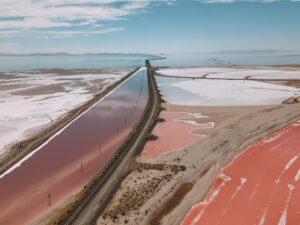Physical Address
23,24,25 & 26, 2nd Floor, Software Technology Park India, Opp: Garware Stadium,MIDC, Chikalthana, Aurangabad, Maharashtra – 431001 India
Physical Address
23,24,25 & 26, 2nd Floor, Software Technology Park India, Opp: Garware Stadium,MIDC, Chikalthana, Aurangabad, Maharashtra – 431001 India

By Vivek Saini
The Great Salt Lake, a once vibrant and expansive body of water, is now facing an unprecedented ecological crisis. Over the past several decades, the lake has shrunk dramatically, losing nearly 73 percent of its water and 60 percent of its surface area. This alarming reduction is largely due to extensive water diversions for agriculture, industrial uses, and the burgeoning population of Utah. Compounding this issue, a severe megadrought, intensified by global warming, has further depleted the lake’s resources. As a result, vast areas of the lakebed are now exposed, transforming them into dusty plains that pose significant environmental and health risks. Scientists and environmentalists are sounding the alarm about the urgent need to address the consequences of this desiccation, which include the emission of greenhouse gasses from the drying lakebed, toxic dust storms, and the disruption of local ecosystems.
The Shrinking Lake
The Great Salt Lake, the largest saltwater lake in the Western Hemisphere, has been steadily shrinking over the past several decades. This reduction is primarily attributed to extensive water diversions for agricultural irrigation, industrial use, and the rapid growth of Utah’s population. The Study indicates that the lake has lost nearly 73 percent of its water and 60 percent of its surface area. The megadrought in the U.S. Southwest, exacerbated by global heating, has further accelerated the lake’s decline. As water levels drop, vast expanses of the lakebed have been exposed, transforming once water-covered regions into arid, dusty plains. This rapid desiccation has not only impacted the local ecosystem, threatening the survival of brine shrimp and millions of migratory birds but also increased the frequency of toxic dust storms. These storms carry harmful substances such as arsenic, mercury, and lead, posing serious health risks to nearby communities.
The ecological impact of the shrinking Great Salt Lake extends beyond its immediate vicinity. The loss of wetlands, which serve as crucial habitats for numerous species of birds, fish, and other wildlife, has led to a decline in biodiversity. Additionally, the drying lakebed has become a significant source of airborne dust pollution, which can travel long distances and affect air quality far from the lake. This situation has prompted urgent calls for action from environmental groups and scientists who warn that without intervention, the consequences for both local ecosystems and human health could be dire. Efforts to mitigate these effects are now more critical than ever as the region continues to grapple with the challenges posed by climate change and water scarcity.
Greenhouse Gas Emissions: A New Climate Threat
Recent research has revealed that the exposed lakebed of the Great Salt Lake is now a significant source of greenhouse gas emissions. A study led by Soren Brothers, a climate change curator at Canada’s Royal Ontario Museum, found that the desiccating lake is releasing millions of tons of carbon dioxide (CO2) and other greenhouse gasses into the atmosphere. The study estimated that in one year, the lake emitted 4.1 million tons of CO2, which is equivalent to about 7 percent of Utah’s annual human-caused emissions. This amount of CO2 is comparable to the emissions from 140 commercial airplanes over the same period. The findings underscore a vicious feedback loop: as the lake dries up due to climate change, it releases more greenhouse gasses, which in turn contribute to further global warming.
This phenomenon is not unique to the Great Salt Lake; other drying saline lakes around the world, such as the Aral Sea in Central Asia, have shown similar emission patterns. These emissions complicate efforts to reduce overall greenhouse gas levels, highlighting the need for comprehensive climate and water management policies. The situation at the Great Salt Lake serves as a stark reminder of the interconnectedness of climate systems and the far-reaching impacts of local environmental changes. Scientists are calling for urgent measures to stabilize the lake’s water levels and prevent further emissions, which include improving water use efficiency and restoring natural inflows to the lake.
Health and Environmental Consequences
The decline of the Great Salt Lake has profound health and environmental consequences. The exposed lakebed, now a source of fine particulate matter (PM2.5), has led to increased air pollution in surrounding areas. This type of dust pollution is particularly harmful because PM2.5 particles can penetrate deep into the lungs and enter the bloodstream, causing respiratory and cardiovascular diseases. Additionally, the dust contains toxic substances like arsenic and mercury, which can lead to long-term health issues, including cancer. Research has shown that minority and low-income communities are disproportionately affected by this pollution, as they are more likely to live downwind of the dust storms.
The ecological impact is equally severe. The lake’s shrinking waters have resulted in the death of brine shrimp, a critical food source for millions of migratory birds. This loss threatens the survival of various bird species that rely on the lake as a stopover during migration. Furthermore, the increasing salinity of the remaining water makes it uninhabitable for native species, disrupting the entire ecosystem. The cumulative effect of these changes is a stark reminder of the interconnectedness of climate, health, and environmental stability. Efforts to address these issues must consider both the immediate health risks and the long-term ecological balance to ensure the sustainability of the region.
References:
https://www.cell.com/one-earth/fulltext/S2590-3322(24)00326-9
https://www.mprnews.org/story/2024/07/27/npr-utah-great-salt-lake-carbon-emissions
https://www.sciencedaily.com/releases/2024/07/240725154711.htm
The Great Salt Lake Is Drying and Our Climate Is Paying the Price
https://earthobservatory.nasa.gov/world-of-change/aral_sea.php
Photo by Urvish Oza on Unsplash